Carbon Atom Distribution and Impact Toughness of High-Carbon Bainitic Steel
Abstract
1. Introduction
2. Experimental Procedures
3. Results
3.1. Bainitic Transformation Time
3.2. Microstructure and Mechanical Property
4. Analysis and Discussion
4.1. The Influence of Carbon Distribution on Toughness
4.2. The Influence of Interface Density on Toughness
4.3. Crack Propagation Path
5. Conclusions
- 1.
- By adjusting the heat treatment method, the carbon content of the tested steel matrix was reduced from 0.89 wt.% to 0.74 wt.%. After the reduction in the matrix carbon content, the incubation period of bainitic transformation in the tested steel was shortened, and the peak rate of bainite transformation increased.
- 2.
- The microstructure of the tested steel under the complete austenite process was composed of bainitic ferrite and retained austenite. The microstructure of the tested steel under the incomplete austenitization process was composed of bainitic ferrite, retained austenite, and undissolved carbide. The latter organization was significantly coarser.
- 3.
- The decrease in the carbon content in the experimental steel matrix caused a decrease in the carbon content in both the bainitic ferrite and medium. At the same time, the volume fraction of the retained austenite decreased from 19.73% to 9.82%.
- 4.
- The carbon content in the matrix of the samples from the complete austenitization process was higher, and the hardness of the tested steel was 58.1 HRC, which had an impact toughness of 26.2 J/cm2. The carbon content in the matrix of the samples from the incomplete austenitization process was lower, and the hardness of the tested steel was 60.1 HRC, which had an impact toughness of 51.2 J/cm2. The hardness and impact toughness of the tested steels with a higher matrix carbon content were lower than those with a lower matrix carbon content. The composition of microstructure phases, interface density, and angle are important factors affecting toughness.
Author Contributions
Funding
Institutional Review Board Statement
Informed Consent Statement
Data Availability Statement
Conflicts of Interest
References
- Zhang, F.C.; Yang, Z.N. Development of and perspective on high-performance nanostructured bainitic bearing steel. Engineering 2019, 5, 319–328. [Google Scholar] [CrossRef]
- Yang, Z.N.; Zhang, F.C.; Ji, Y.L.; Wang, Y.H.; Lv, B.; Wang, M. Notably improved mechanical properties via introducing a short austempering treatment on low-carbon martensite steel. Mater. Sci. Eng. A 2016, 673, 524–529. [Google Scholar] [CrossRef]
- Wei, Z.R.; Wang, W.; Liu, M.; Tian, J.Y.; Guang, X. Comparison of wear performance of bainitic and martensitic structure with similar fracture toughness and hardness at different wear conditions. Wear 2023, 512–513, 204512. [Google Scholar] [CrossRef]
- Liu, Y.R.; Tan, Z.L.; Tian, Y.; Zhu, J.Q.; Zhang, M.; Zhang, M.R.; Zhao, C.H. Temperature-dependent crack induced by microstructure evolution in 20Mn2SiMoCuV bainite wheel steel. Eng. Fail. Anal. 2022, 140, 106593. [Google Scholar] [CrossRef]
- Yang, Z.N.; Zhang, F.C. Nanostructured bainitic bearing steel. ISIJ Int. 2020, 60, 18–30. [Google Scholar] [CrossRef]
- Fielding, L.C.D.; Jones, N.G.; Walsh, J.; Boxel, S.V.; Blackmur, M.S.; Lee, P.D.; Withers, P.J.; Stone, H.J.; Bhadeshia, H.K.D.H. Synchrotron analysis of toughness anomalies in nanostructured bainite. Acta Mater. 2016, 105, 52–58. [Google Scholar] [CrossRef]
- Garcia-Mateo, C.; Caballero, F.G. Ultra-high-strength bainitic steels. ISIJ Int. 2005, 45, 1736–1740. [Google Scholar] [CrossRef]
- Lu, X.H.; Qian, D.S.; Li, W.; Jin, X.J. Enhanced toughness of bearing steel by combining prior cold deformation with martensite pre-quenching and bainite transformation. Mater. Lett. 2019, 234, 5–8. [Google Scholar] [CrossRef]
- Chakraborty, J.; Bhattacharjee, D.; Manna, I. Development of ultrafine bainite + martensite duplex microstructure in SAE 52100 bearing steel by prior cold deformation. Scr. Mater. 2009, 61, 604–607. [Google Scholar] [CrossRef]
- Lan, H.F.; Du, L.X.; Li, Q.; Qiu, C.L.; Li, J.P.; Misra, R.D.K. Improvement of strength-toughness combination in austempered low carbon bainitic steel: The key role of refining prior austenite grain size. J. Alloys Compd. 2017, 710, 702–710. [Google Scholar] [CrossRef]
- Kumar, A.; Singh, A. Improvement of strength-toughness combination in nanostructured bainite. Procedia Struct. Integr. 2018, 13, 548–553. [Google Scholar] [CrossRef]
- Kumar, A.; Singh, A. Toughness dependence of nano-bainite on phase fraction and morphology. Mater. Sci. Eng. A 2018, 729, 439–443. [Google Scholar] [CrossRef]
- Peet, M.J.; Fielding, L.C.D.; Hamedany, A.A.; Rawson, M.; Hill, P.; Bhadeshia, H.K.D.H. Strength and toughness of clean nanostructured bainite. Mater. Sci. Technol. 2017, 33, 1171–1179. [Google Scholar] [CrossRef]
- Li, X.C.; Lu, G.Y.; Wang, Q.C.; Zhao, J.X.; Xie, Z.J.; Misra, R.D.K.; Shang, C.J. The effects of prior austenite grain refinement on strength and toughness of high-strength low-alloy steel. Metals 2022, 12, 28. [Google Scholar] [CrossRef]
- Li, J.; Zhang, C.; Liu, Y. Influence of carbides on the high-temperature tempered martensite embrittlement of martensitic heat-resistant steels. Mater. Sci. Eng. A 2016, 670, 256–263. [Google Scholar] [CrossRef]
- Xu, W.; Huang, M.H.; Wang, J.L.; Shen, C.G.; Zhang, T.Y.; Wang, C.C. Review: Relations Between Metastable Austenite and Fatigue Behavior of Steels. Acta Metall. Sin. 2020, 56, 459–475. [Google Scholar]
- Zhao, H.Z.; Lee, Y.K.; Liu, X.H.; Wang, G.D. Effects of austenite grain size on bainite transformation kinetics in AISI 4340 steel. Trans. Mater. Heat Treat. 2006, 27, 59–62. [Google Scholar]
- Lan, L.Y.; Chang, Z.Y.; Fan, P.H. Exploring the difference in bainite transformation with varying the prior austenite grain size in low carbon steel. Metals 2018, 8, 988. [Google Scholar] [CrossRef]
- Sadahiro, Y.; Hiroyasu, Y.; Katsumi, Y.; Masakazu, N. Effects of the austenite grain size and deformation in the unrecrystallized austenite region on bainite transformation behavior and microstructure. ISIJ Int. 2007, 35, 1020–1026. [Google Scholar]
- He, S.H.; He, B.B.; Zhu, K.Y.; Ding, R.; Chen, H.; Huang, M.X. Revealing the role of dislocations on the stability of retained austenite in a tempered bainite. Scr. Mater. 2019, 168, 23–27. [Google Scholar] [CrossRef]
- Singh, S.B.; Bhadeshia, H.K.D.H. Estimation of bainite plate-thickness in low-alloy steels. Mater. Sci. Eng. A 1998, 245, 72–79. [Google Scholar] [CrossRef]
- Cornide, J.; Garcia-Mateo, C.; Capdevila, C.; Cabllero, F.G. An assessment of the contributing factors to the nanoscale structural refinement of advanced bainitic steels. J. Alloys Compd. 2013, 577, 43–47. [Google Scholar] [CrossRef]
- Garcia-Mateo, C.; Caballero, F.G.; Sourmail, T.; Kuntz, M.; Cornide, J.; Smanio, V.; Elvira, R. Tensile behaviour of a nanocrystalline bainitic steel containing 3wt% silicon. Mater. Sci. Eng. A 2012, 549, 185–192. [Google Scholar] [CrossRef]
- Hu, J.; Li, X.Y.; Meng, Q.W.; Wang, L.Y.; Li, Y.Z.; Xu, W. Tailoring retained austenite and mechanical property improvement in Al–Si–V containing medium Mn steel via direct intercritical rolling. Mater. Sci. Eng. A 2022, 855, 143904. [Google Scholar] [CrossRef]
- Zhang, F.C.; Yang, Z.N. Retained Austenite in Bainitic Steel; Yanshan University Press: Qinhuangdao, China, 2019; pp. 169–170. [Google Scholar]
- Xiong, X.C.; Chen, B.; Huang, M.X.; Wang, J.F.; Wang, L. The effect of morphology on the stability of retained austenite in a quenched and partitioned stee. Scr. Mater. 2013, 68, 321–324. [Google Scholar] [CrossRef]
- Morsdorf, L.; Tasan, C.C.; Ponge, D.; Raabe, D. 3D structural and atomic-scale analysis of lath martensite: Effect of the transformation sequence. Acta Mater. 2015, 95, 366–377. [Google Scholar] [CrossRef]
- Caballero, F.G.; Miller, M.K.; Garcia-Mateo, C. Carbon supersaturation of ferrite in a nanocrystalline bainitic steel. Scr. Mater. 2010, 58, 2338–2343. [Google Scholar] [CrossRef]
- Caballero, F.G.; Miller, M.K.; Babu, S.S.; Garcia-Mateo, C. Atomic scale oobservations of bainite transformation in a high carbon high silicon steel. Acta Mater. 2007, 55, 381–390. [Google Scholar] [CrossRef]
- Tu, X.; Shi, X.; Shan, Y.; Yan, W.; Shi, Q.Q.; Li, Y.F.; Li, C.S.; Yang, K. Tensile deformation damage behavior of a high deformability pipeline steel with a ferrite and bainite microstructure. Mater. Sci. Eng. A 2020, 793, 139889. [Google Scholar] [CrossRef]
- Kondo, S.; Mitsuma, T.; Shibata, N.; Ikuhara, Y. Direct observation of individual dislocation interaction processes with grain boundaries. Sci. Adv. 2016, 2, e1501926. [Google Scholar] [CrossRef]
- Kammouni, A.; Saikaly, W.; Dumont, M.; Marteau, C.; Bano, X.; Charaï, A. Effect of the bainitic transformation temperature on retained austenite fraction and stability in Ti microalloyed TRIP steels. Mater. Sci. Eng. A 2009, 518, 89–96. [Google Scholar] [CrossRef]
- Hidalgo, J.; Findley, K.O.; Santofimia, M.J. Thermal and mechanical stability of retained austenite surrounded by martensite with different degrees of tempering. Mater. Sci. Eng. A 2017, 690, 337–347. [Google Scholar] [CrossRef]
- Hu, H.J.; Tian, J.Y.; Xu, G.; Zurob, H.S. New insights into the effects of deformation below-Ms on isothermal kinetics of bainitic transformation. J. Mater. Res. Tech. 2020, 9, 15750–15758. [Google Scholar] [CrossRef]
- Qin, Y.M.; Liu, C.B.; Zhang, C.S.; Wang, X.B.; Long, X.Y.; Li, Y.G.; Yang, Z.N.; Zhang, F.C. Comparison on the wear resistance of nanostructured bainitic bearing steel with and without residual cementite. J. Iron. Steel. Res. Int. 2022, 29, 339–349. [Google Scholar] [CrossRef]
- Wang, X.L.; Xie, Z.J.; Wang, Z.Q.; Yu, Y.S.; Wu, L.Q.; Shang, C.J. Crystallographic study on microstructure and impact toughness of coarse grained heat affected zone of ultra-high strength steel. Mater. Lett. 2022, 323, 132552. [Google Scholar] [CrossRef]
- Huang, M.; Wang, C.; Wang, L.; Wang, J.; Mogucheva, A.; Xu, W. Influence of DIMT on impact toughness: Relationship between crack propagation and the α′-martensite morphology in austenitic steel. Mater. Sci. Eng. A 2022, 844, 143191. [Google Scholar] [CrossRef]
- Kitahara, H.; Ueji, R.; Tsuji, N.; Minamino, Y. Crystallographic features of lath martensite in low-carbon steel. Acta Mater. 2006, 54, 1279–1288. [Google Scholar] [CrossRef]
- Wang, X.L.; Wang, Z.Q.; Dong, L.L.; Shang, C.J.; Ma, X.P.; Subramanian, S.V. New insights into the mechanism of cooling rate on the impact toughness of coarse grained heat affected zone from the aspect of variant selection. Mater. Sci. Eng. A 2017, 704, 448–458. [Google Scholar] [CrossRef]
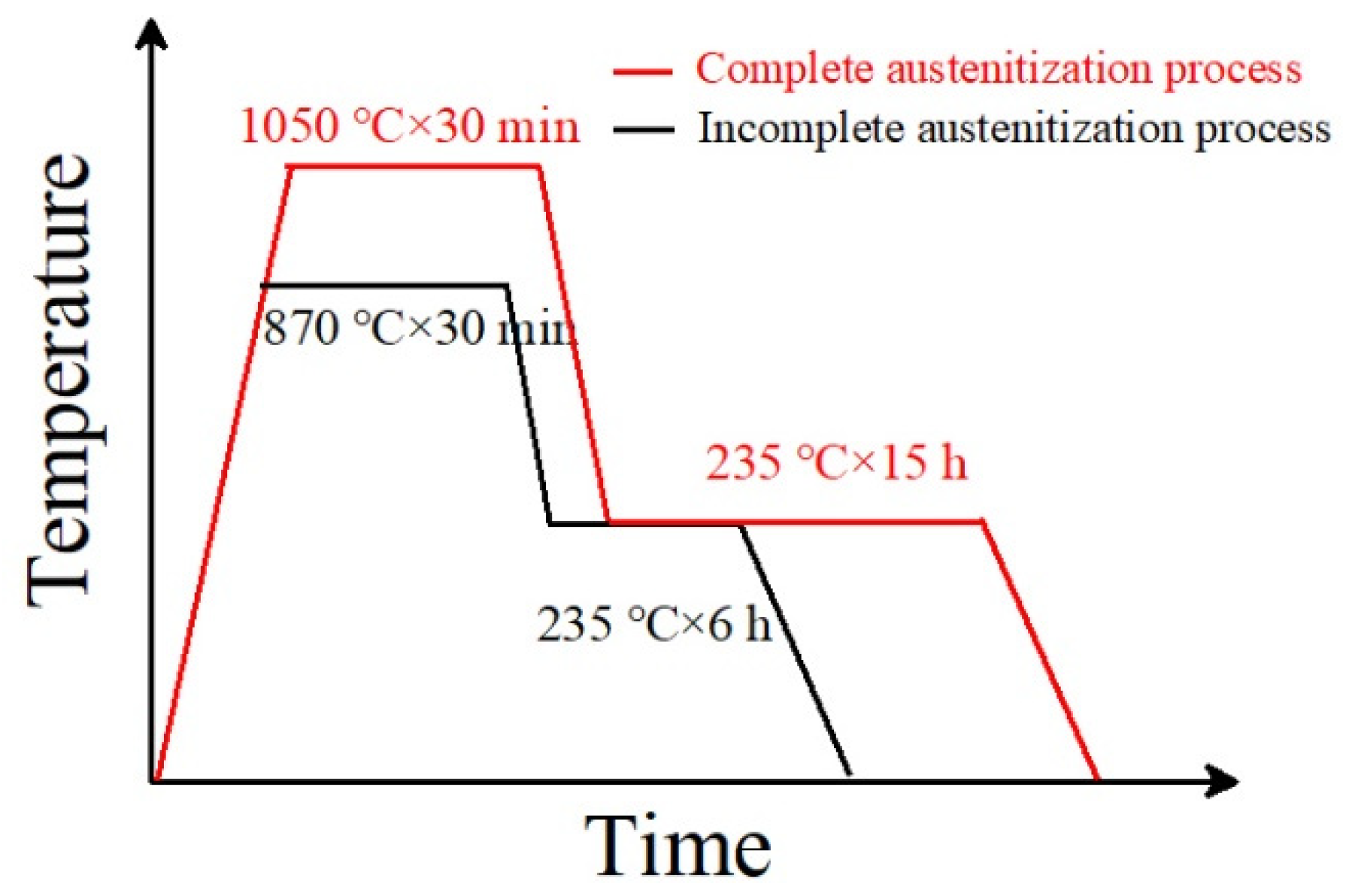
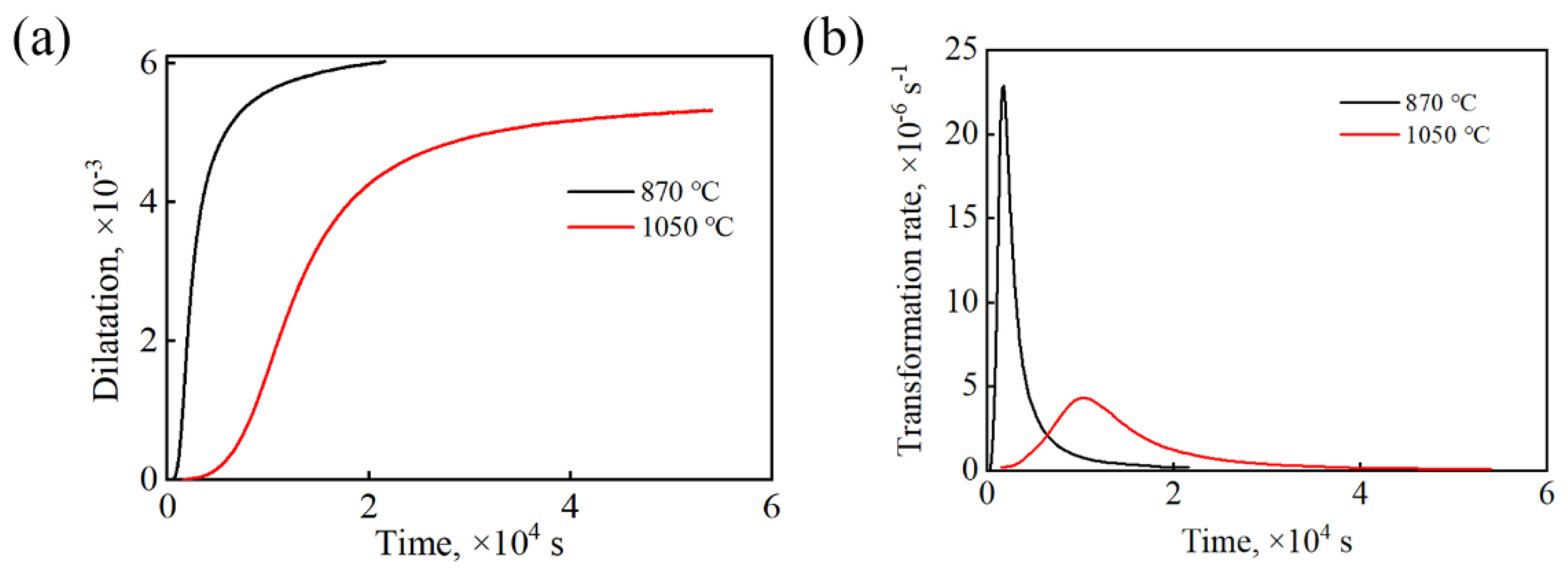

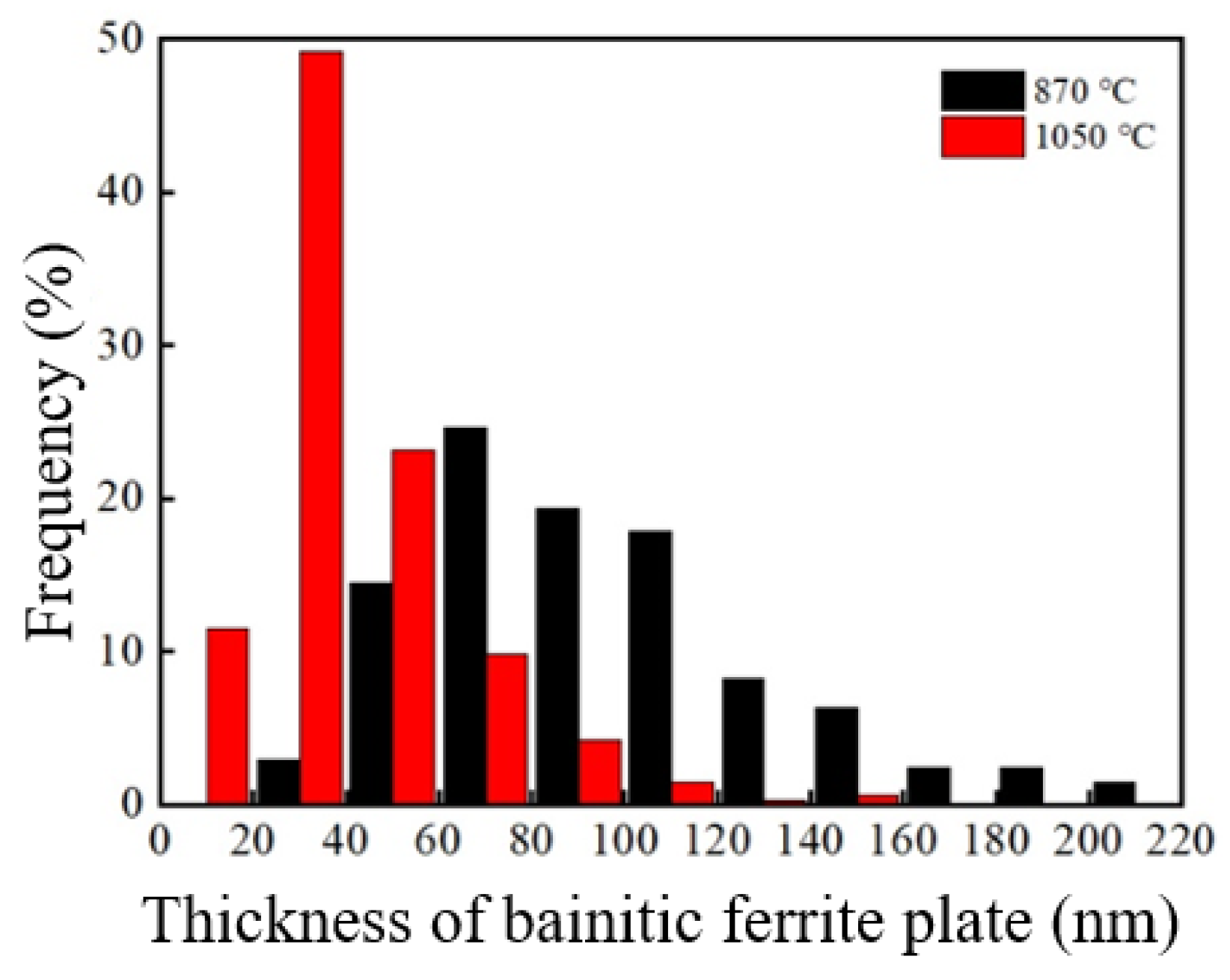
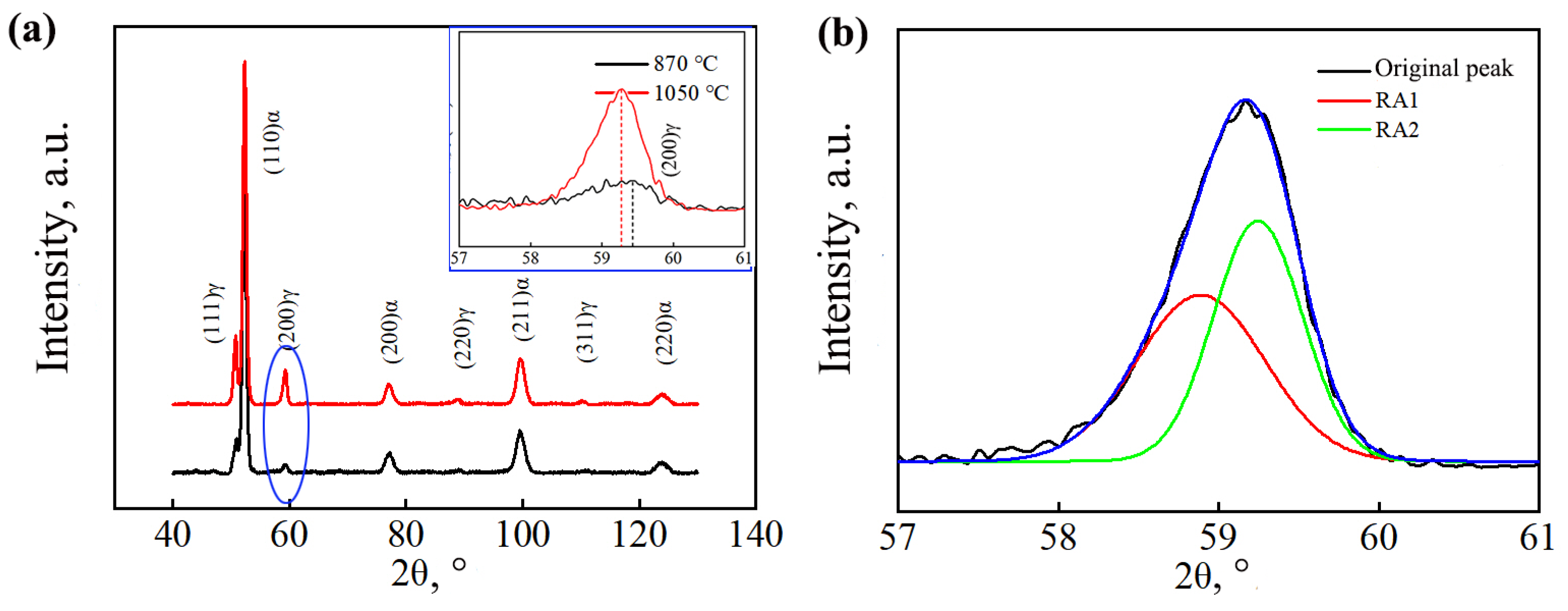
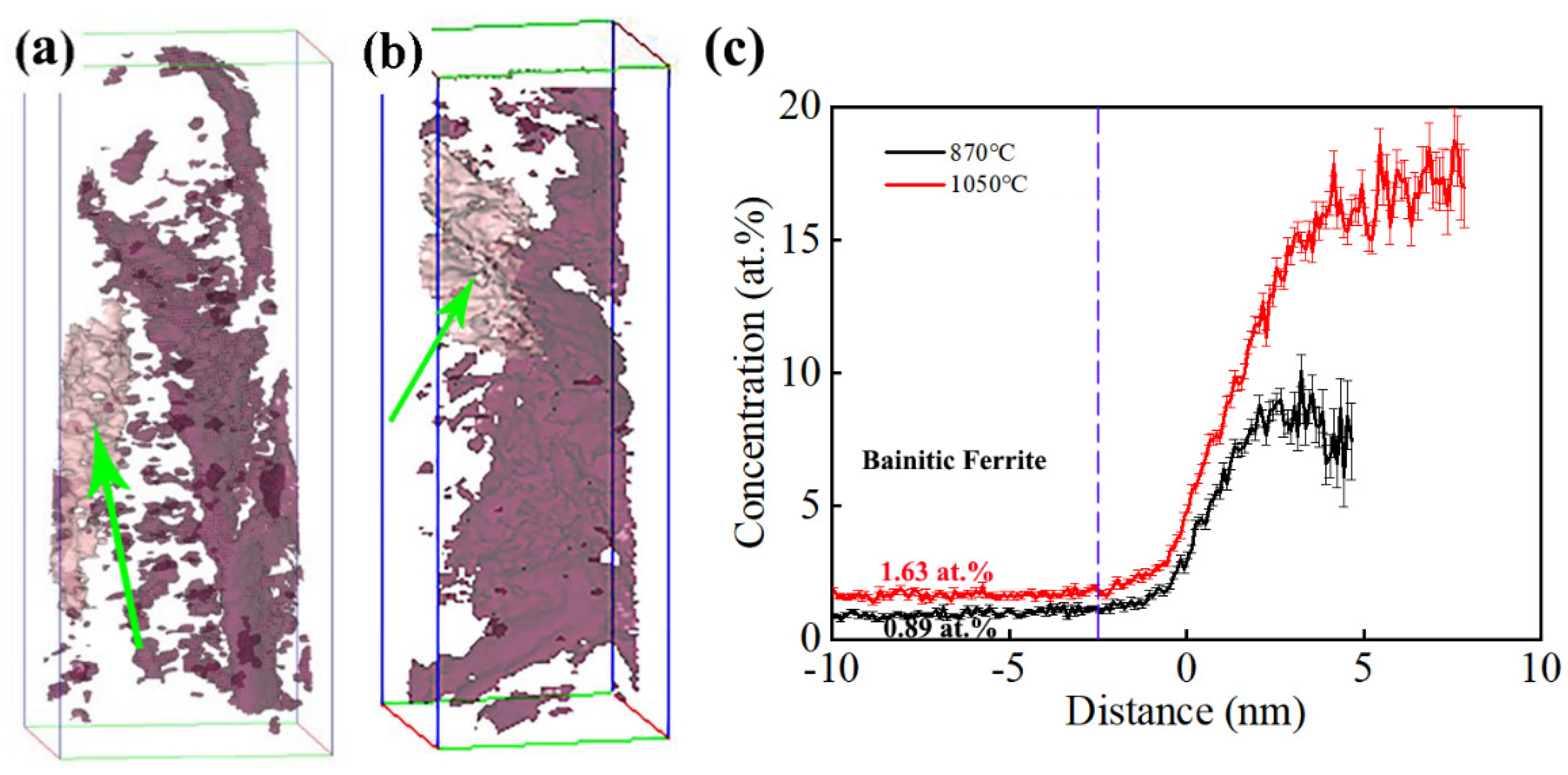
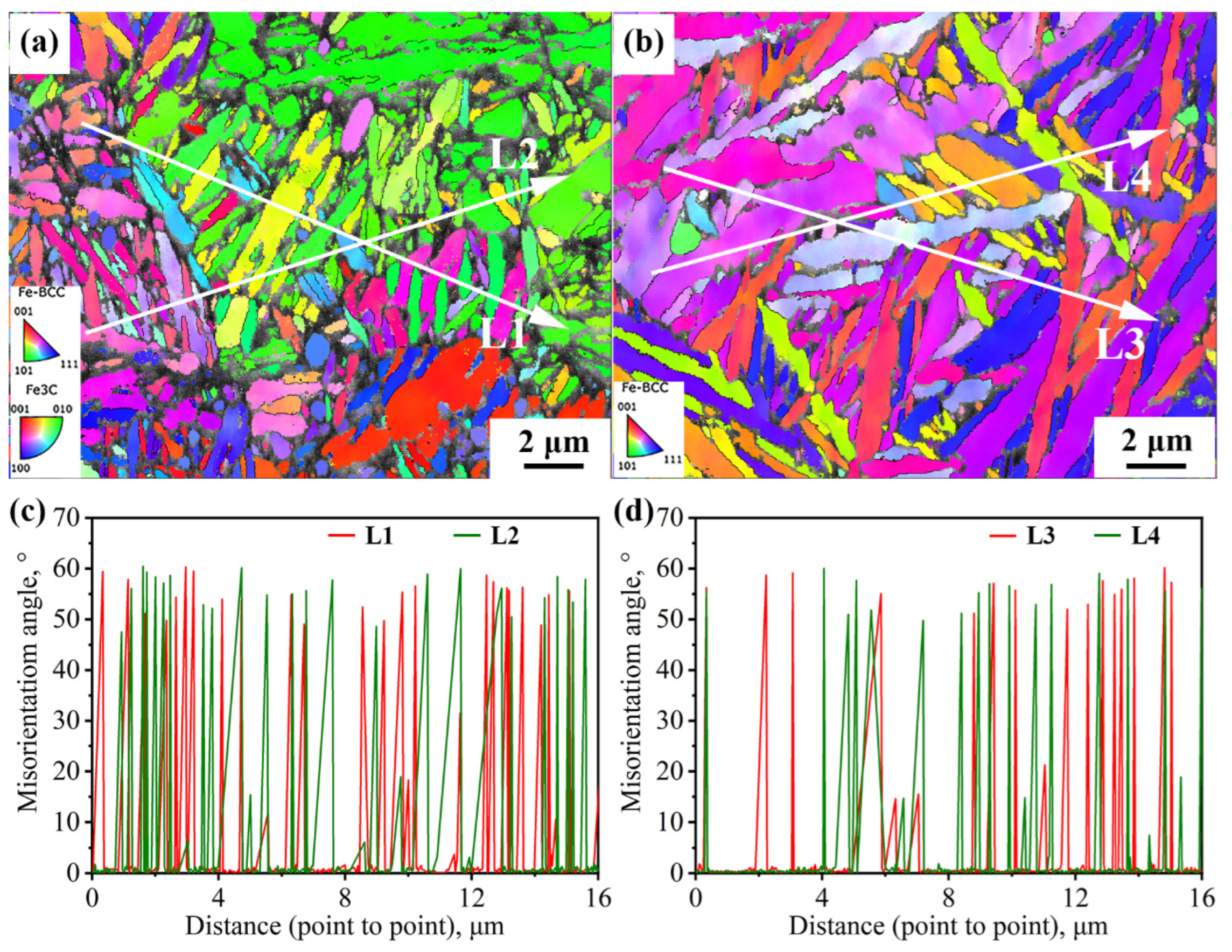
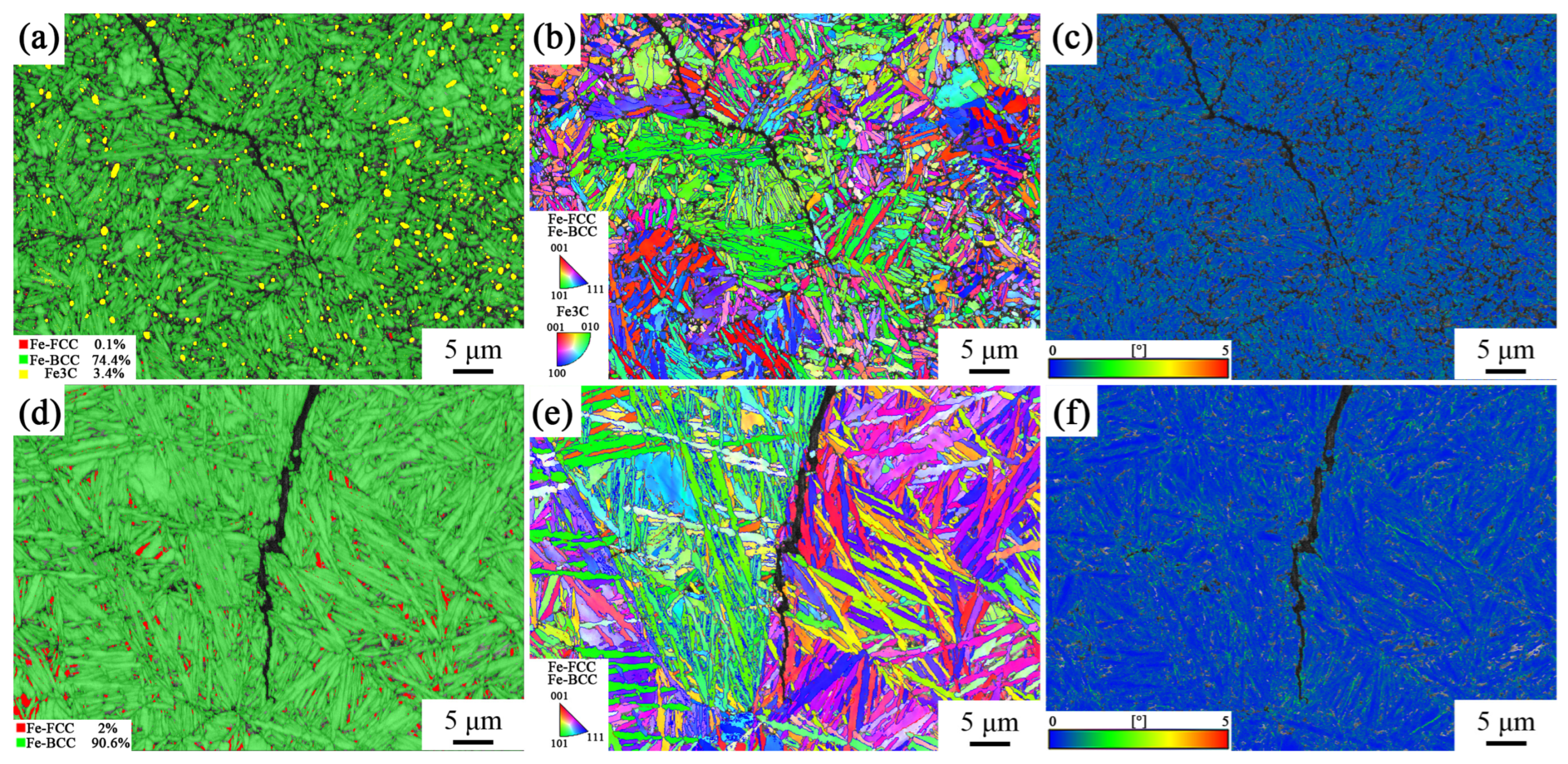

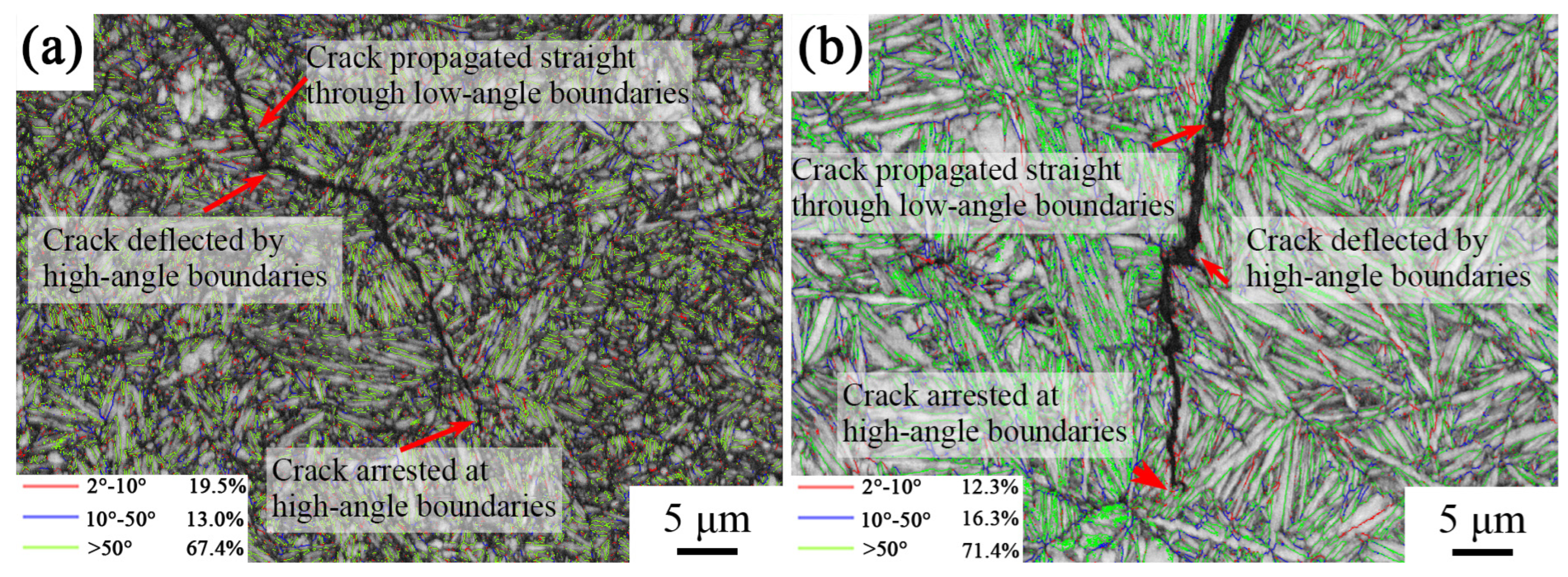
| Process | tBF/nm | /% | /wt.% | /% | /wt.% | /% | /wt.% |
|---|---|---|---|---|---|---|---|
| 870 °C | 93.6 ± 1.7 | 9.82 | 1.02 | 4.32 | 0.86 | 5.50 | 1.61 |
| 1050 °C | 41.1 ± 1.4 | 19.73 | 1.29 | 8.73 | 1.20 | 11.00 | 1.65 |
| Process | HRC | aK/J·cm−2 |
|---|---|---|
| 870 °C | 60.1 ± 1.0 | 51.2 ± 6.5 |
| 1050 °C | 58.1 ± 0.1 | 26.2 ± 1.0 |
Disclaimer/Publisher’s Note: The statements, opinions and data contained in all publications are solely those of the individual author(s) and contributor(s) and not of MDPI and/or the editor(s). MDPI and/or the editor(s) disclaim responsibility for any injury to people or property resulting from any ideas, methods, instructions or products referred to in the content. |
© 2024 by the authors. Licensee MDPI, Basel, Switzerland. This article is an open access article distributed under the terms and conditions of the Creative Commons Attribution (CC BY) license (https://creativecommons.org/licenses/by/4.0/).
Share and Cite
Long, X.; Dai, Z.; Wang, W.; Yang, Z.; Zhang, F.; Li, Y. Carbon Atom Distribution and Impact Toughness of High-Carbon Bainitic Steel. Coatings 2024, 14, 457. https://doi.org/10.3390/coatings14040457
Long X, Dai Z, Wang W, Yang Z, Zhang F, Li Y. Carbon Atom Distribution and Impact Toughness of High-Carbon Bainitic Steel. Coatings. 2024; 14(4):457. https://doi.org/10.3390/coatings14040457
Chicago/Turabian StyleLong, Xiaoyan, Zhao Dai, Wanshuai Wang, Zhinan Yang, Fucheng Zhang, and Yanguo Li. 2024. "Carbon Atom Distribution and Impact Toughness of High-Carbon Bainitic Steel" Coatings 14, no. 4: 457. https://doi.org/10.3390/coatings14040457
APA StyleLong, X., Dai, Z., Wang, W., Yang, Z., Zhang, F., & Li, Y. (2024). Carbon Atom Distribution and Impact Toughness of High-Carbon Bainitic Steel. Coatings, 14(4), 457. https://doi.org/10.3390/coatings14040457






